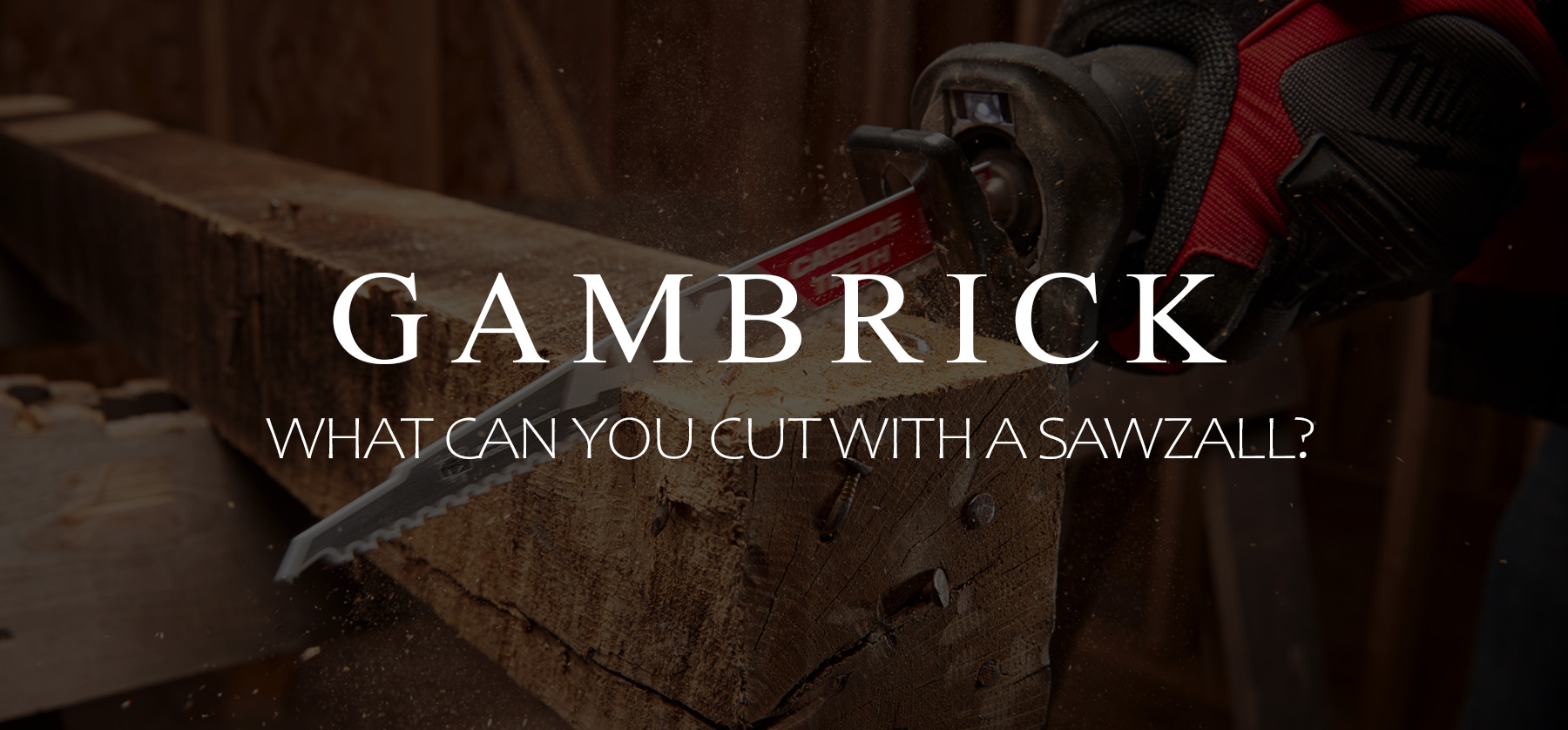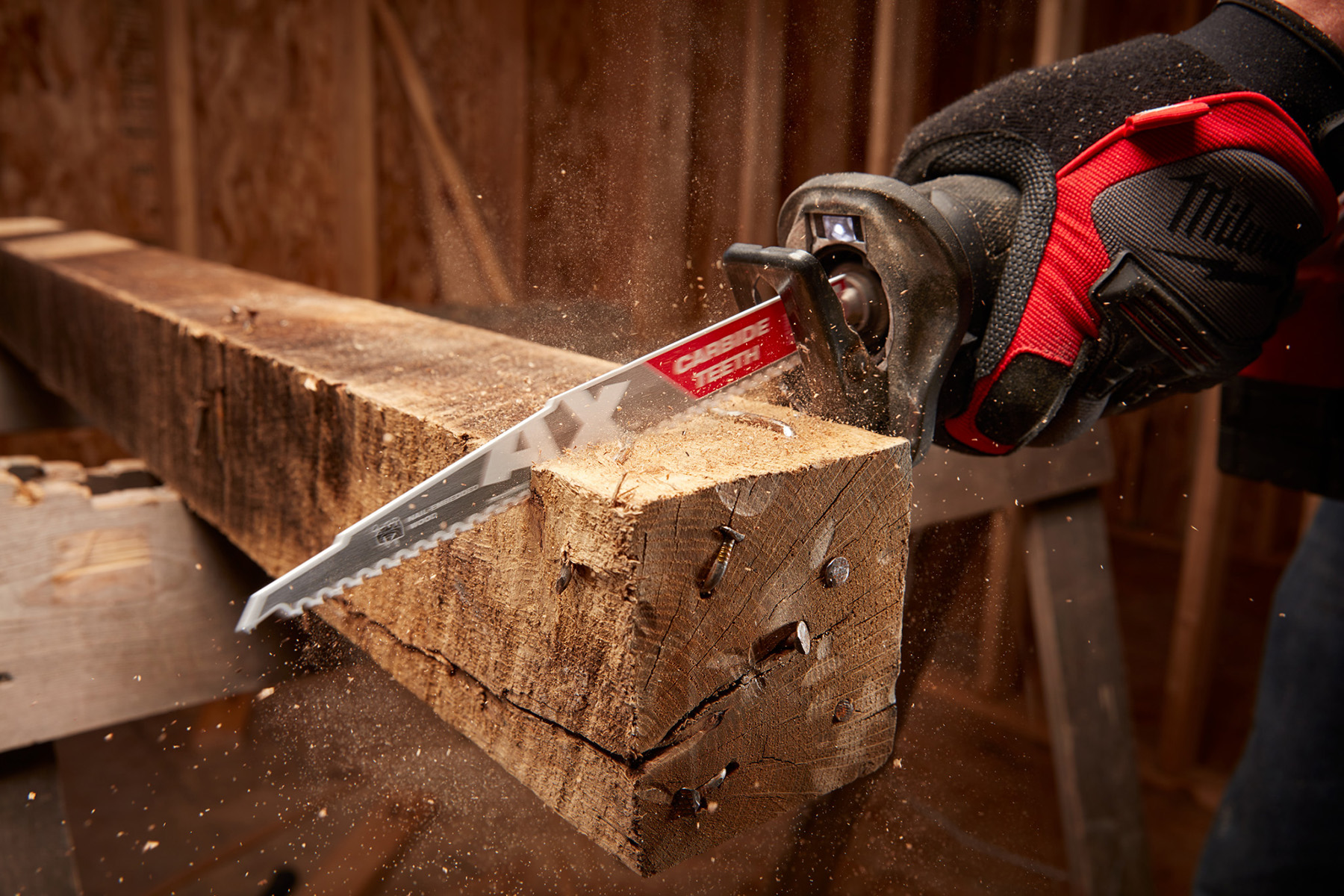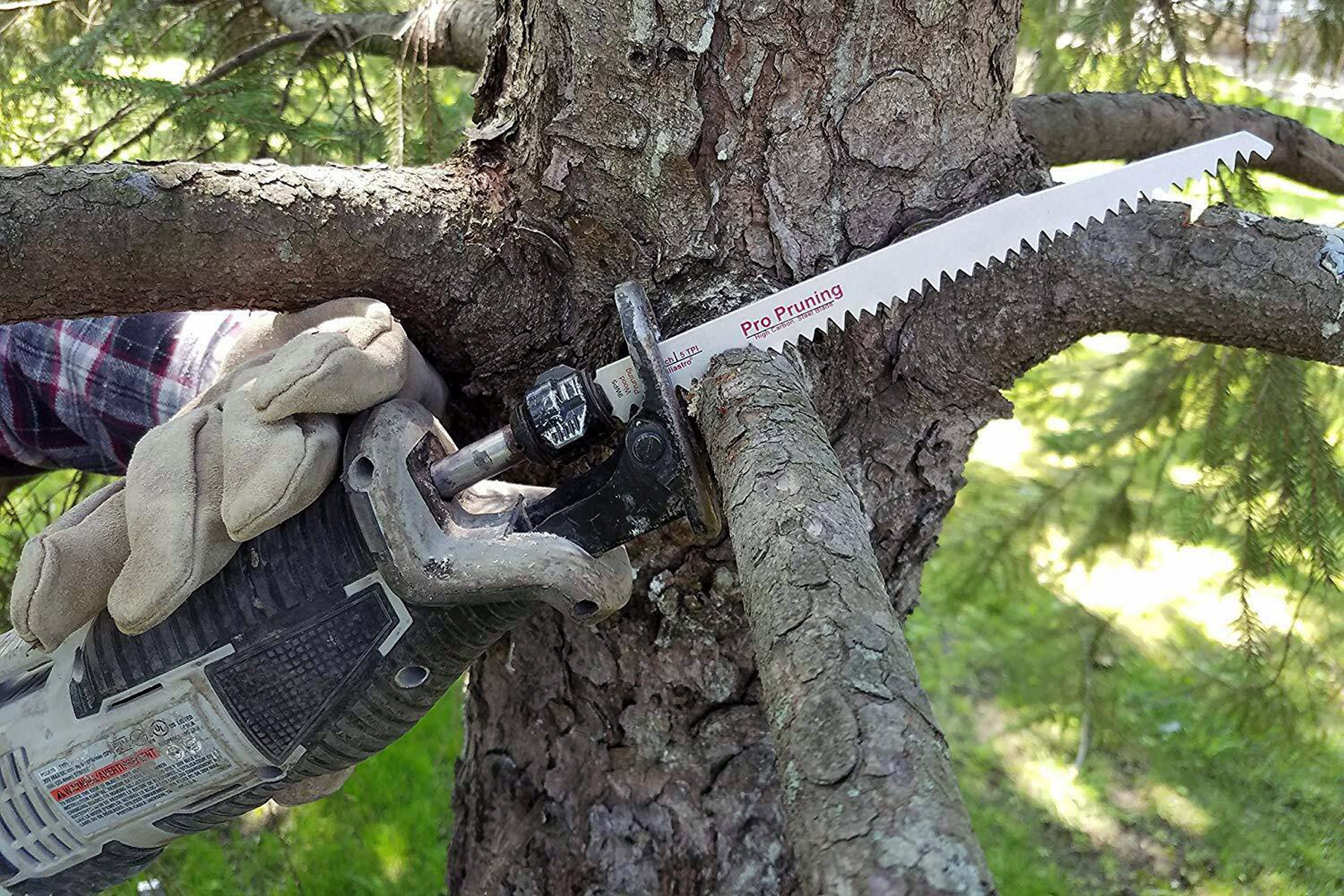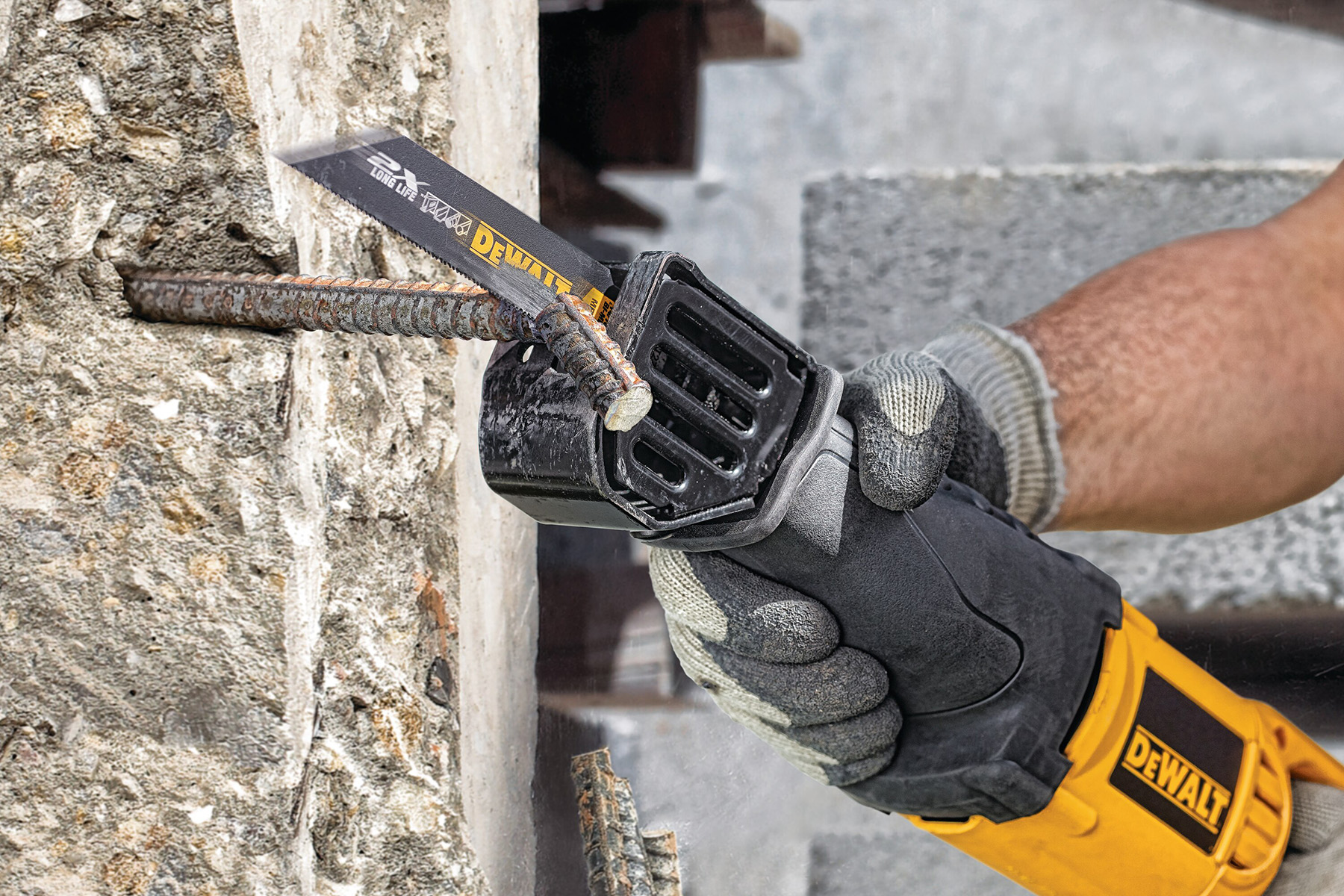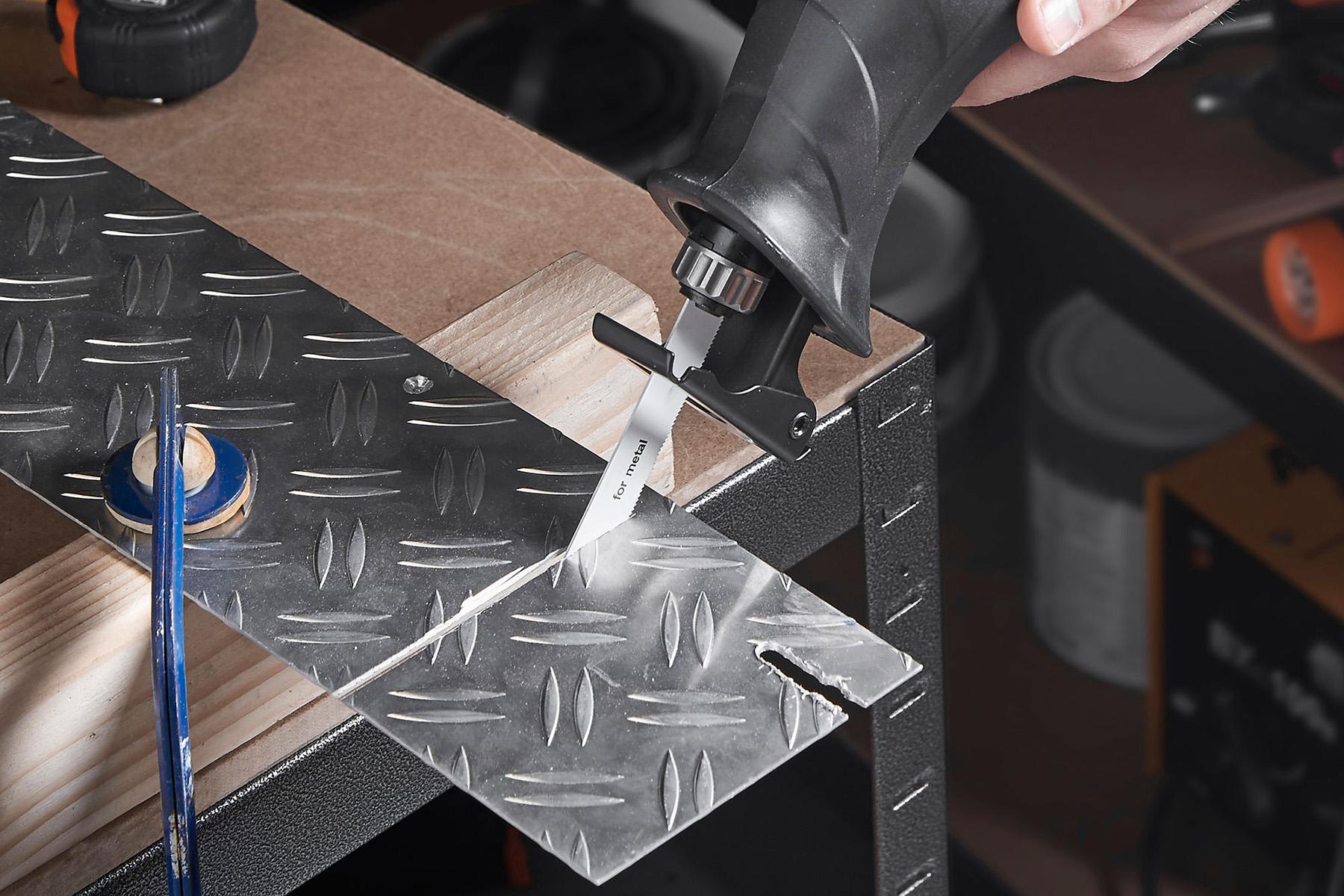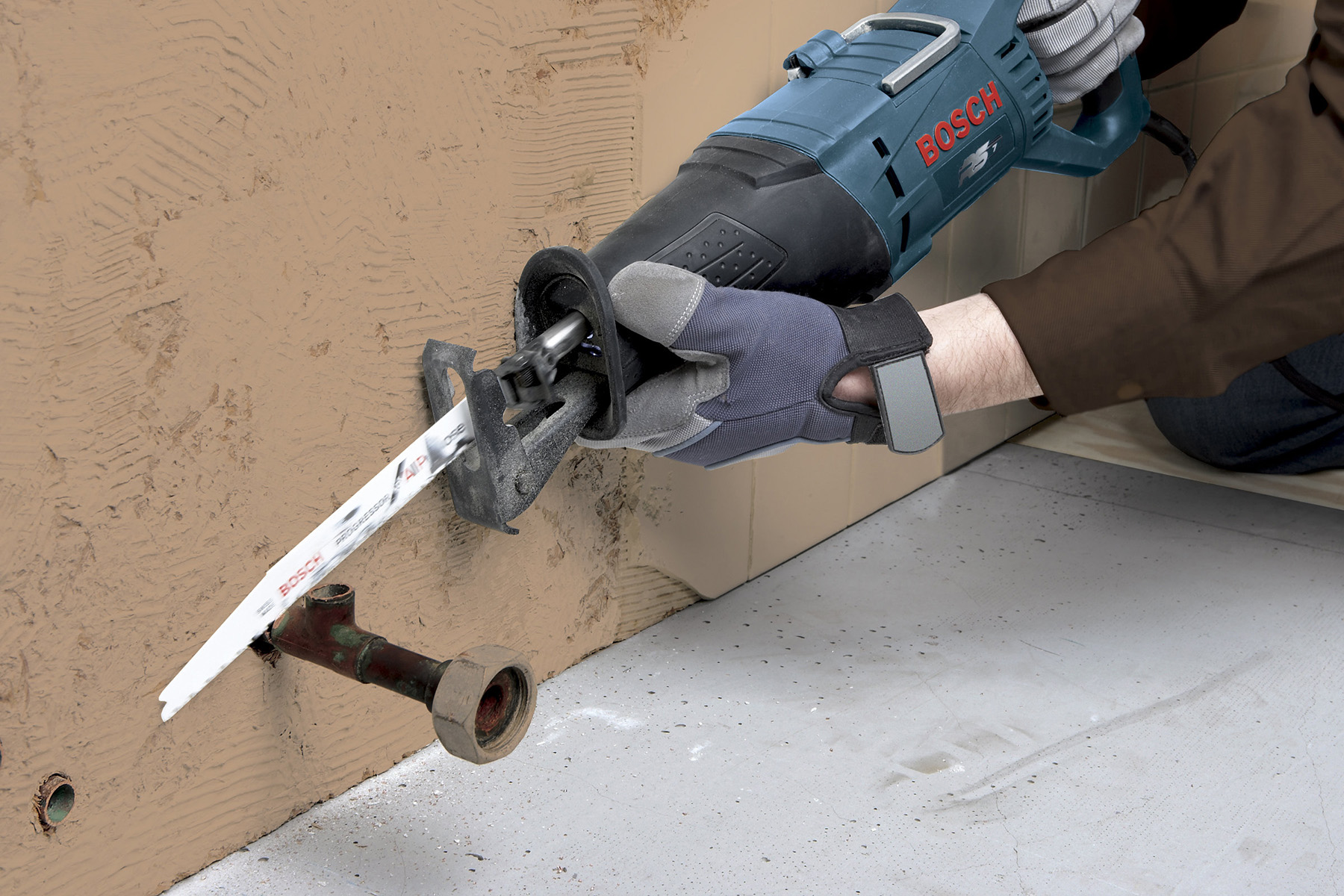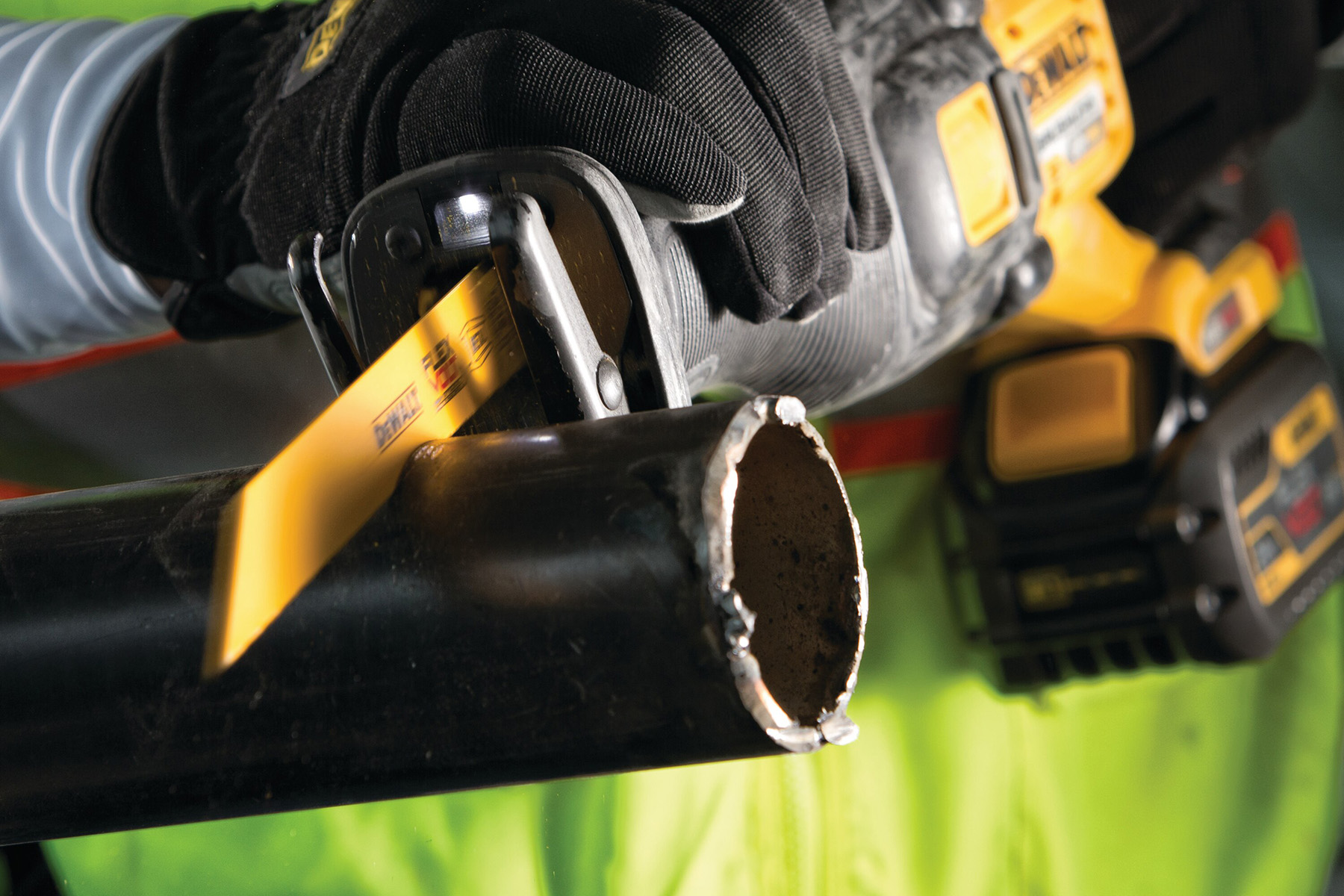What Can You Cut With A Sawzall?
Sawzall is the brand name of a reciprocating saw that’s made by Milwaukee. The way a Sawzall works is by rocking a long thin toothed blade back and forth against a material to cut it. Not all Sawzall or reciprocating saws are created equal. They come in a variety of designs with different power outputs usually measured in either amps or volts. Just about every tool manufacturer makes their own version of a Sawzall in either cored or battery powered configurations. Blades are easy to swap in and out of the saw in a matter of seconds. And it’s the blade that makes the saw so unique and versatile. What can you cut with a Sawzall? Just about any material as long as you have the correct blade and a strong enough saw.
Wood, concrete, cement, PVC, metal, rebar, copper, plastic, trees, you name it. There’s a Sawzall blade designed to cut through just about every material you can think of.
There are two things to consider when cutting through tough material. The blade and the saw’s power. The more important of the two being the blade. A Sawzall or any other reciprocating saw is only as good as the blade you’re using. Once the blade goes dull, the saw loses it’s ability to cut efficiently. When cutting through hard, dense materials like metal or concrete, you need both the correct blade and also a powerful saw. This is usually shown as amperage if the saw is corded or volts if it has a battery. The higher the number, the more power the Sawzall typically has. Power paired with a good blade is enough to cut through pretty much any material.
Ahead we’ll go through a wide list of materials a Sawzall or reciprocating saw can cut through, how many amps you should have and the correct blade.
What Is A Sawzall?
Before we get into all the things a Sawzall can cut, let’s talk a little bit about what a Sawzall is and the blades.
Sawzall is a type of reciprocating saw made by the Milwaukee Tool company. Many people refer to all reciprocating saws as Sawzalls but it’s actually just the name of the saws made by Milwaukee.
It’s a very good name because a reciprocating saw can pretty much saw all materials. The way the tool works is by rocking a long thin blade back and forth at high speed. The speed is controlled by the trigger. The harder you press, the faster the saw goes.
When it comes to cutting with a Sawzall, or any reciprocating saw, it’s all about the blade. With the right blade you can cut through just about anything. Manufacturers make blades for clean wood, wood with nails, metal, masonry, plaster, fiberglass, composite materials, cast iron, trees, concrete and a lot more. If you’ve ever done any type of demolition work then you’ll know how versatile and essential a Sawzall is on the job.
Blades range in length from 3 to 12 inches and have two basic designs, teeth or grit.
- Teeth Blades have lots of sharp teeth. The amount of teeth a blade has is measured in TPI or Teeth Per Inch. The more teeth the blade has the finer the cut. In general, metal blades have lots of teeth and demo blades have just a few.
- Grit Blades are coated with either Carbide or Diamond dust. They’re great for grinding all sorts of really tough materials.
Sawzalls cut in a back-and-forth rocking motion, similar to how a hacksaw works.
The head of the saw has a quick change chuck and a guard that rests on the material you’re cutting. The guard comes in handy when cutting things pike PVC or copper pipe because it helps keep the cut straight.
Sawzall Blade Teeth
Choosing the right reciprocating saw blade for the material you’re cutting is very important. There’s no one blade that’s best for every material.
Sawzall blades have either teeth or a grit coating. Teeth blades cut through a material while grit blades grind through.
The design and amount of teeth a blade has effects what type of material that blade can cut and how it cuts it. For example, a demo wood blade will have fewer larger teeth while a finish cut wood blade has fewer and smaller teeth.
Here’s a breakdown of Sawzall blade teeth and what they’re best for:
- The number of teeth per inch (TPI), the size of the tooth in length, height and width and the amount of space between the teeth, determines the material the blade can cut and what type of cut it makes.
- Blades with a low TPI deliver faster cuts with rougher edges. They’re great for demo work and rough cutting wood.
- Blades with a high TPI deliver smooth, slow cuts and are great for metal or cutting wood with a fine edge.
- The number of TPI ranges from three to 24.
- Try to have at least 2-3 teeth come in contact with the material at all times to reduce snagging.
Sawzall Blade Dimensions
Sawzall blades come in a wide variety of shapes and sizes. Some are thick, thin, long, short, fat and oddly shaped.
There are three main dimensions you should pay attention to: length, width and thickness. Reciprocating saw blades range from 3 to 12 inches long.
- The longer the blade, the thicker material it can cut.
- Wider blades reduce bending and wobbling as you cut.
- Heavy duty blades tend to be .875-inches wide and 0.062-inches thick. These are great for cutting through thick and dense materials.
- Blades 0.035-inches thick are enough for most standard cuts.
- Blades 0.05-inches thick provide enhanced stability for cuts that need a lot of pressure.
- Short blades with tapered backs are best for plunge-cuts of when you need more control.
- Specialty blades are available for odd materials like cutting drywall.
Sawzall Blade Composition
What the Sawzall blade is made of has a lot to do with the material it’s designed to cut.
There are different types of Sawzall reciprocating saw blades on the market that are all designed for a different purpose. Choosing the right one is essential to making a clean and efficient cut. Most reciprocating saw blades are made of carbon steel, high-speed steel, bi-metal or carbide grit.
Here’s what you should know about the different Sawzall blade types:
- Carbon steel blades are flexible to allow bending without breaking. They’re great for cutting wood or plastic.
- Carbon steel blades are generally the best Sawzall blades for trees and branches.
- High-speed steel blades have durable teeth that are great for cutting metal.
- Bi-metal blades combine high-speed steel teeth for longevity and heat resistance, with a carbon-steel body for flexibility and break-resistance.
- Carbide or Diamond grit blades are used for materials such as fiberglass, ceramic tile, tough metal, cast iron, concrete, brick and cement board.
Demolition Sawzall Blades
Sawzall blades designed for all around demolition work are made from strong metal that’s hard to dull. They come in a variety of lengths, widths and TPI.
Teeth Per Inch (TPI): 6
- Used for demolition work in nail-embedded wood
Teeth Per Inch (TPI): 10
- Used for demolition work in nail-embedded wood
- Fire and rescue
- Cuts through heavy-duty pipe, structural steel and stainless steel
- Stainless steel: 1/8″ to 1″
Teeth Per Inch (TPI): 10/14
- Cuts through heavy-duty pipe, structural steel and stainless steel
- Stainless steel: 3/16″ to 3/4″
Teeth Per Inch (TPI): 14
- Cuts through heavy-duty pipe, structural steel and stainless steel
- Stainless steel: 3/32″ to 3/8″
Teeth Per Inch (TPI): 18
- Fire and rescue
- Stainless steel: 1/16″ to 1/4″
Can You Cut Wood With A Sawzall?
A Sawzall and other reciprocating saws are designed to cut through wood. It doesn’t matter how dense the wood is, with the right blade a Sawzall can cut through it.
Most Sawzall blades are designed to cut through wood, but there are different types of wood. If it’s a fresh piece of lumber you can use a blade meant for wood without nails. However, if you’re demolishing a house use a Demo blade that’s designed to cut through wood with nails. This is a big difference because blades meant strictly to cut through wood will dull really fast when they hit a nail. I’ve done it plenty of times and the blade can cut through the nail, but it ruins the blade.
Don’t use a blade designed strictly to cut through wood if there are nails because it will quickly dull the blade.
Apply pressure on the saw blade against the wood and let the saw do the work. Don’t press too hard because you can bind the blade. If you’re having trouble cutting, rock the saw back and forth along the cut line to saw the wood from different angles.
Most wood is Doug Fir or some other type of pine. But a Sawzall can cut through any type of wood including denser species like Ipe or Oak. However, for dense wood you need a more aggressive blade. Use a demo blade for wood with nails or a metal blade.
Ipe and some other Brazilian Hardwoods are so dense that you need a metal blade to cut through them. Most wood blades bounce right off or spark.
How Much Power Do You Need?
It doesn’t take much power to cut through most types of lumber with a Sawzall. 3-4 amps or 20 volts is usually enough if you have a good blade. However, if you’re cutting through a dense board like Ipe decking, I’d recommend around 24 volts or 5 amps.
Wood shouldn’t give a sawzall much trouble if there are no nails unless it’s extremely dense. Stay away from knots because these areas can be denser wood.
What Type Of Blade Works Best?
Use a wood cutting blade at least 2 inches longer than the wood you’re cutting. If your wood has nails, make sure to buy a blade that says it’s for nails. They have special teeth that can cut through wood and metal.
If you’re cutting extremely dense wood like Ipe decking, use a metal blade. Standard wood blades have trouble cutting through Ipe.
Most wood species, including dense wood like oak, can be cut with a standard wood cutting blade. It’s only extremely dense species like Ipe or Exotic Hardwoods that give the saw trouble. These woods are almost entirely used to make decking. In these cases try a metal blade.
Knots are not like cutting through regular wood fibers. A knot can be very dense. Stay away from them with a standard blade if you can. But if you have to cut through a tough knots, try a metal blade or a wood blade that can cut through nails.
Can You Cut A Tree With A Sawzall?
You can cut a tree with a Sawzall or other brand reciprocating saw. A Sawzall with the right blade is strong enough to cut through even the densest of wood like Apple, Ipe or Oak.
If the tree is small enough, you can cut it down with a Sawzall.But the blade needs to pass completely through the trunk with at least 2 inches to spare. For example, a 12″ blade can cut through a 10″ trunk. This is because the blade needs to rock back and forth in order to cut the tree. If the trunk is thicker than the blade is long, the blade won’t be able to rock without banging it’s tip on the wood.
Sawzalls are great for cutting up tree branches. I use them all the time for pruning trees and bushes. Buy as long a blade as possible because they’re easier to work with and can cut thicker branches.
A demo blade for wood without nails works best on most trees. However for really dense wood I use something more aggressive. Extremely dense trees can be like cutting through metal so you need a different type of tooth. Some manufacturers make blades specifically for trees that are called pruning blades.
Bear in mind, Sawzalls are best for cutting stationary material. If there’s a lot of play in your branch or limb, the saw will shake it rather than cutting through it. When you cut a branch, make sure to hold it tight so that it can’t vibrate with the saw.
How Much Power Do You Need?
It doesn’t take much power to cut most trees and branches with a Sawzall. 3-4 amps or 20 volts is usually enough if you have a good blade. However, if you have a thick tree or dense wood, I’d recommend around 24 volts or 5 amps.
Trees don’t usually give a sawzall trouble because there are no nails. Stay away from knots because these areas can be denser wood.
What Type Of Blade Works Best?
Use a demo blade at least 2 inches longer than the tree you’re cutting. I typically like to buy the longest blade they sell even when the tree is thin. This gives me more teeth to cut with as the blade starts to dull.
Use a demo blade for wood without nails or a pruning blade. These will be good enough for most trees.
If you’re cutting extremely dense tree wood like Apple or Ipe, use a more aggressive blade. I use a demo blade that can cut through wood with nails or a metal cutting blade.
Can You Cut Concrete With A Sawzall?
You can cut through solid concrete slabs with a Sawzall using either a special concrete Sawzall blade or a diamond or Carbide coated masonry blade.
Most people don’t realize that a Sawzall and other reciprocating saws can cut through solid concrete. You need a special blade and a powerful saw to do it, but with the right combo it’s actually not that hard.
Just like when cutting wood, choose a blade that’s at least 2 inches longer than the concrete is thick. As the saw rocks the blade back and forth, you need the blade to clear the material on the up stroke and the down stroke. I also like a little room between the tip of the saw’s guard and the material. A 2 inch buffer is usually enough.
- Toothed concrete blades are very strong and chip the concrete away to cut through it.
- Grit masonry blades are very different. They’re coated with a super strong Diamond or Carbide coating that grinds the concrete as the saw rocks back and forth.
Both types of blades produce a lot of heat so take your time with the cut. Take breaks or wet the cut with water as you go to reduce heat and dust.
If you hit rebar that’s a big problem. The Carbide or Diamond tip can cut through it but you’ll wear out the blade. A toothed concrete sawzall blade can’t. If the slab has rebar or wire mesh, use a grit blade or do like I do and switch blades when you hit the metal.
How Much Power Do You Need?
Using a Sawzall or other reciprocating saw to cut through concrete requires a powerful saw. I recommend using a corded saw with at least 12 amps. Corded saws are much stronger than the cordless version.
Sawing through concrete takes more pressure than wood so you really need to press hard. This also puts a lot of pressure on the saw which can bind a weak saw’s blade. More power means you can apply more pressure onto the concrete.
What Type Of Blade Works Best?
There are two types of Sawzall blades that will cut through concrete, toothed and grit. Use a toothed blade for concrete without rebar or wire mesh and a grit blade for concrete with rebar or wire. I like to use both. Start cutting with the toothed blade and then switch to a Diamond or Carbide grit blade when you hit the metal. Once clear of the metal, switch back to the toothed blade.
Can You Cut Rebar With A Sawzall?
A Sawzall with a fine tooth metal blade is an excellent choice for cutting rebar. As long as you have the correct metal blade, the Sawzall, or any other reciprocating saw, will cut right through it.
Rebar is made of steel which is something a Sawzall metal blade can cut. Even thick rebar, like 5/8″, is not problem for a Sawzall. But rebar is dense so the blade will eventually dull. Luckily even thick rebar is fairly narrow compared to the length of a blade so you have a lot of teeth to work with. As one area gets dull, cut with a different section of the blade.
Sawzall blades coated with grit like Diamond or Carbide will cut through steel rebar too, but I recommend using the metal blade. They’re designed to cut rebar when it’s outside of concrete. However, when rebar is inside a concrete slab, use the grit blade. A regular metal Sawzall blade won’t cut concrete.
When you cut through rebar make sure to hold it still. Rebar is thin and easy to vibrate. If the rebar starts shaking with the saw blade it’ll be difficult to cut.
There are a few different tools that can cut through or snap rebar but I actually prefer using a Sawzall. Grinders spark too much and chop saws are immobile. With my sawzall I can go right to the rebar pile and cut them to size quickly and easily.
A Sawzall makes a very accurate and straight cut once you get the hang of it. The key is the get started on a square line. If you start the blade on an angle it’ll follow that angle and you’ll get a pointed end which is not what you want.
How Much Power Do You Need?
It doesn’t take much power to cut through steel rebar with a Sawzall. 3-4 amps or 20 volts should be more than enough if you have the right blade. A cordless sawzall will work fine.
What Type Of Blade Works Best?
Use either a grit or metal Sawzall blade to cut through rebar.
I use the metal blade when cutting rebar that’s outside of concrete. But I use a Diamond or Carbide grit Sawzall blade when cutting rebar inside a concrete slab. This is because metal blades won’t cut concrete but grit blades will.
If I’m using a metal blade to cut rebar all by itself, I like a short blade. it gives me a little more control. Part of the challenge of cutting rebar with a Sawzall is keeping it from vibrating like crazy as you cut it.
However if I’m cutting through a concrete slab that has rebar in it, I use a blade at least 2 inches longer than the slab is wide. This allows the blade to rock back and forth without hitting its tip on he concrete.
Can You Cut PVC With A Sawzall?
Cutting PVC is super easy with a Sawzall. Any power saw will do it and any blade. However, some blades are better than others.
The best Sawzall blade for cutting PVC is the Milwaukee M12. It has 12 small teeth per inch which easily and accurately cut through PVC pipe with a very clean edge. Even though any blade can cut through PVC, the blades with more and smaller teeth give a cleaner cut.
Rough blades designed for wood leave a really jagged messy cut. They’ll do the job but not well. If you want a professional looking cut then use an M12 or something similar.
Metal cutting Sawzall blades work really well on PVC because they have lots of small teeth per inch. If you don’t have an M12 use a metal blade with a 14TPI.
The power of the Sawzall doesn’t matter because PVC is a soft material. Any saw will do fine. Even the really small mini Sawzalls will work.
I like to use as short a blade as possible but still 2 inches longer than the pipe. If you cut a lot of 4″ PVC use a 6″ blade. Shorter blades give me better control. I like to rest the pipe right up against the Sawzall guard as I cut. The guard helps be cut a square line through the pipe. As long as the PVC is pressed squarely against the guard, the cut will be straight.
Can You Cut Metal With A Sawzall?
Reciprocating Sawzall blades can easily cut through all types of metal. The key to a successful cut is using the right type of blade for the material you’re cutting. There are different types of metal ranging from soft metals like copper or aluminum to hard metals like steel or cast iron. As long as you have the right blade, a Sawzall can cut through it.
In terms of power, just about any standard size Sawzall can cut through metal. It doesn’t matter if it’s battery powered or corded. I’ve even tried the smaller mini Sawzalls and they cut through metal just fine. I actually prefer using a mini Sawzall when I’m doing plumbing work because they’re much lighter and easy to carry around.
If you buy a mini Sawzall I recommend getting one with at least an 18volt battery. Anything less runs out of juice much too fast. Even 18V is a bit on the low side but for now it’s the best they make for such a small tool. If you’re making lots of cuts, go with a full size Sawzall and a 24V battery or a plug in. They’ll last all day and then some.
Metal blades come in a variety of designs with different teeth per inch.
Here’s a quick breakdown by TPI and what they’re best used for:
Teeth Per Inch (TPI): 14
- Pipe, structural steel and stainless steel: 3/32″ to 1/4″
- Nonferrous metal: 3/32″ to 3/8″
- Hard rubber
Teeth Per Inch (TPI): 18
- Pipe, structural steel, stainless steel and conduit: 1/16″ to 3/16″
- Nonferrous metal: 1/16″ to 5/16″
- Contour cutting in metal: 1/16″ to 1/8″
Teeth Per Inch (TPI): 24
- All metals less than 1/8″
- Tubing, conduit and trim
Can You Cut Drywall With A Sawzall?
Yes, a Sawzall blade will cut through drywall like butter. But should use a Sawzall to cut drywall and if so, which blade works best.
Milwaukee makes a small 2 1/2″ Sawzall blade specifically to cut through drywall. I’ve tested it out and it works great. It’s probably the best Sawzall blade I’ve tried because it reduces the amount of dust kicked up into the air. And that’s the main problem with using a Sawzall or any reciprocating saw blade to cut drywall. Even though any Sawzall blade can cut drywall, they create a lot of dust.
Metal blades work better for cutting drywall than demo blades. Smaller more frequent teeth make a finer cut which cuts down on dust. I use a metal blade with 14 TPI. Before I started using the Milwaukee drywall blade and when I don’t have one on hand,I use a metal blade.
I make all my big drywall cuts with a knife. But when I have to cut out recessed lights, outlets, pipes,etc. I use a mini Sawzall and a drywall or metal blade. They’re great for cutting shapes if the drywall’s on the wall or being prepped for install.
I usually stab the blade tip through the drywall first before I start cutting with power. Then once it’s through, I start cutting slowly. You don’t need full power to cut through a sheet of drywall. Pulling the trigger 1/4 to 1/2 is usually more than enough. I prefer a slower cut because it gives me more control and cuts down on dust even further.
Can You Cut Plexiglass With A Sawzall?
A Sawzall will cut through plexiglass if you have the right blade. Plexiglass is a type of plastic called thermoplastic and not glass. It’s fairly soft compared to hard woods and metal but tends to splinter crack. I use a metal blade with a very high 18 to 24 TPI to cut it. A high TPI Sawzall blade will make a clean cut through plexiglass without chipping or cracking it.
Take your time with the cut and don’t use full power. I use about 1/4 to 1/2 speed on my mini Sawzall. Let the saw teeth do the work. Don’t apply too much pressure on the plexiglass. Use just enough the make the cut. Speed isn’t as important as accuracy.
I’ve tried Diamond and Carbide grit Sawzall blades too and they worked fine but I prefer a toothed blade. Grit blades tend to grind the plexiglass into a melted clump around the cut. Toothed blades leave a smoother more accurate edge.
Both a mini and full size Sawzall will cut plexiglass, but this is a finesse cut. You don;t need a lot of power to cut plexiglass, it’s all about the blade and controlling the speed. I prefer a small saw because it’s not as powerful and gives me more control over my cut and the speed of the blade.
Can You Cut Copper Pipe With A Sawzall?
A Sawzall or any other reciprocating saw can easily cut through a copper pipe if you have the right blade. The blade I recommend is a metal cutting blade with 18 to 24 TPI. 14 TPI blades will work too but I prefer more teeth. A higher tooth count creates a sharper cut with a smoother edge.
Copper is a fairly soft metal so it’s easy to cut. You don’t need a powerful Sawzall. Small mini Sawzalls have more than enough power to cut through copper.
Any blade, including wood blades, can cut through a copper pipe. But they leave a rough and jagged edge and go dull much faster. You need a clean straight edge when cutting copper that you intend to use as piping. To ensure the cut is clean, use a metal cutting blade with a high TPI count.
I use a mini Sawzall made by Milwaukee with a high TPI blade to cut copper when I intend to use the pipe. Place the pipe flat against the saw guard to ensure you get a right angle cut.
After I cut the pipe I sand the edge inside and out with some very fine grit sandpaper. This removes any burrs that have formed while cutting.
If you’re cutting through copper pipes on a demo job, I’d use a full size Sawzall with a metal cutting demo blade. Demo blades will cut through copper with ease and leave a jagged edge but it doesn’t matter because you’re not installing the pipe.
Can You Cut Brick With A Sawzall?
Brick can be cut with a Sawzall using a toothed or grit masonry blade. Brick is a hard material compared to soft wood or PVC, but it’s not as hard as concrete, most metals or Ipe wood. If you have the right blade and a standard full size Sawzall, bricks are easy to cut.
Toothed masonry blades work just like wood, metal or demo Sawzall blades. The saw rocks the blade back and forth allowing its strong teeth to cut through the brick. In reality, the teeth are actually chipping small chunks out of the brick which creates the effect of a cut.
Grit blades work a little different but have the same result. The blades grit grinds the brick in a line which creates the cut.
Both Sawzall tooth blades and grit blades will cut through a brick. However the difference is in the dust. Grit blades create a lot of brick dust and tooth blades create small chips of brick. For this reason I prefer the toothed blade.
When you use a Sawzall to cut a brick, go slow at first. Once the blade is into the brick about 1/4 inch, go full power. The starter cut will keep the blade in line as you apply more power. Press down on the brick fairly hard while cutting. Bricks aren’t that dense so it doesn’t take much force.
Not all bricks are created equal. Newer, denser fire house bricks are harder to cut than older more rustic bricks which tend to be brittle. Take a look at your brick, if you see lots of holes and pits it’ll be easier to cut through. However if it’s very solid with no texture, it’ll be a little harder to cut.
Can You Cut Cast Iron With A Sawzall?
Cast iron is an extremely dense metal containing between 2% to 4 % carbon. It’s far to dense to cut with most metal cutting blades. However, cast iron can be cut with a Sawzall if you use a diamond grit blade. Cast iron is very hard to cut with a toothed blade, but it can be ground through using a tough grit. Grinders work great at cutting through cast iron which is why the diamond grit Sawzall blade works so well.
Make sure the blade is at least 2 inches longer than the cast iron you’re cutting. The blade I use is 9 inches long which means it can cut cast iron pipes or tubs 7 inches thick or less.
Start cutting the cast iron slowly at first until you get about 1/4 inch into the material. Then use full power The starter cut will help you stay in line. Cast iron is very dense, if you try to cut it at full power without a starting cut the blade can jump around on you.
When cutting a cast iron pipe, if the pipe is 7 inches or less you can cut right through the entire pipe in one pass. However, if the pipe is larger then cut one side of the pipe at a time working your way around the pipe. The tip of the blade will be inside the pipe as you cut.
When cutting a cast iron tub, break the tub loose so you can move it on its side as you cut. First, cut the side of the tub that’s facing you, then flip the tub on its side. Once on its side, you can cut the side of the tub that was facing the wall and the bottom.
Cast iron is so dense that it can spark as you cut it. Don’t worry though because it’s normal.
Cast iron is very heavy so you may need to cut it into several sections with your Sawzall. Make sure you bring enough blades because they go dull fast.
How Much Power Do You Need?
I recommend using a full size Sawzall with at least 3-4 amps or 20 volts. Both a cordless or corded sawzall will work fine.
What Type Of Blade Works Best?
I recommend using a 9 inch diamond grit Sawzall blade to cut through cast iron.
One blade is fine if you’re cutting a cast iron pipe but for a tub I’d bring at least 2. The last cast iron tub I cut up was so heavy I needed to cut it into 8 pieces which required 4 blades.
Can You Cut A Tire With A Sawzall?
A tire can be cut by a Sawzall or other reciprocating saw but you need the right blade. Tires are not just rubber. They also contain a steel inner lining. The rubber part of the tire can be cut with pretty much any Sawzall blade, but you need either a grit or metal blade to cut through the steel lining. I recommend using a metal Sawzall blade with at least a 14 TPI or a grit blade with either a diamond or carbide coating.
Tires are not all created equal. Small tires designed for a compact passenger car are very different from off-road truck tires. In general, the bigger the tire the thicker the rubber and steel lining will be. For large tires I’d bring more than one blade. The steel lining is tough and can quickly dull a blade.
Make sure to buy a blade at least 2 inches wider than the tire if you plan on cutting straight through it. However if the tire is really large you won’t be able to get a blade long enough to pass through the entire tire. In this case I’d use a small 6 inch blade and slowly work my way around the tire a little as at a time.
Can You Cut A Lock With A Sawzall?
To cut through a steel pad-lock use a Sawzall, or other reciprocating saw, and a grit blade. Either a carbide or diamond coated blade will cut through hard steel.
A steel lock is thin so you don;t need a long blade. I recommend using one around 6 inches long. Shorter blades give you more control and better leverage.
Use a full size Sawzall with at least 3-4 amps or 20 volts. You’ll have to apply a fair amount of pressure to get through the lock so the bigger the Sawzall the better.
Hardened steel will wear out a Sawzall blade pretty fast so bring an extra just in case.
I’ve tried toothed Sawzall blades and they didn’t work, the hardened steel of the pad-lock was too dense for the teeth to cut into. But a carbide or diamond coating can grind it down. Be prepared to see some sparks. The last time I cut a lock with a Sawzall the blade sparked a lot.
Can You Cut A Bolt With A Sawzall?
Bolts are easy to cut with a Sawzall if you have the right blade. Use a Carbide or Diamond coated grit Sawzall blade and not a tooth blade. Most good quality bolts are made of hardened steel which is easier to cut with a grit blade.
Toothed blades may work too if it’s good quality. I’d recommend a Milwaukee blade with at least an 18 TPI. I’ve tried cutting bolts with cheap toothed blades and the teeth ground down before I could get all the way through the bolt. I switched to a Milwaukee and was able to finish easily. The quality of the blade matters a lot when cutting through hardened steel bolts.
Make sure the bolt stays really still as you cut. If it starts spinning due to the vibration of the saw it’ll be much harder to cut.
Can You Cut Aluminum With A Sawzall?
Aluminum is a fairly soft metal used to make all sorts of automotive and household parts. It’s easy to cut through with a Sawzall metal blade or a grit blade. I recommend using a metal blade with at least a 14 TPI or a diamond or Carbide grit.
Aluminum is such a soft metal that any size Sawzall can cut it. Even a small mini Sawzall will work fine. And it doesn’t take much pressure on the saw. Press down firmly but not too hard and let the blade do the work.
Cutting aluminum will leave burrs on the floor and a rough edge. The higher the TPI count the finer the edge.
Once I’m done cutting I usually use a small 6 ” file to clean the edges.
Can You Cut A 4×4 With A Sawzall?
A 4×4 is easy to cut with a Sawzall. Make sure to use a blade at least 2 inches longer than the 4×4. In this case a 6 inch blade is plenty. If you’re cutting the 4×4 in half a 6″ blade is long enough to cut right through it.
If the 4×4 has nails in it, use a combo demo blade designed for wood and nails. However, if it’s new wood that’s clean, use a standard wood blade.
You can rip cut a 4×4 down the middle with a Sawzall. Stand the 4×4 up and cut down the middle until you’re past half way. Then flip the 4×4 over and complete the cut. Don’t rip cut the 4×4 while it’s laying down or the Sawzall blade will cut into the ground.
Can You Cut A 6×6 Railroad Tie With A Sawzall?
A 6×6 railroad-tie is easy to cut with a Sawzall. Make sure to use a blade at least 2 inches longer than the 6×6. In this case an 8 inch blade is plenty. If you’re cutting the 6×6 in half an 8″ blade is long enough to cut right through it.
If the 6×6 has nails in it, use a combo demo blade designed for wood and nails. However, if it’s new wood that’s clean, use a standard wood blade.
You can rip cut a 6×6 down the middle with a Sawzall. Stand the 6×6 up and cut down the middle until you’re past half way. Then flip the 6×6 over and complete the cut. Don’t rip cut the 6×6 while it’s laying down or the Sawzall blade will cut into the ground.
Summary: What Can You Cut With A Sawzall?
Sawzall is the brand name of a reciprocating saw that’s made by Milwaukee. The way a Sawzall works is by rocking a long thin toothed blade back and forth against a material to cut it. Not all Sawzall or reciprocating saws are created equal. They come in a variety of designs with different power outputs usually measured in either amps or volts. Just about every tool manufacturer makes their own version of a Sawzall in either cored or battery powered configurations. Blades are easy to swap in and out of the saw in a matter of seconds. And it’s the blade that makes the saw so unique and versatile. What can you cut with a Sawzall? Just about any material as long as you have the correct blade and a strong enough saw.
Wood, concrete, cement, PVC, metal, rebar, copper, plastic, trees, you name it. There’s a Sawzall blade designed to cut through just about every material you can think of.
There are two things to consider when cutting through tough material. The blade and the saw’s power. The more important of the two being the blade. A Sawzall or any other reciprocating saw is only as good as the blade you’re using. Once the blade goes dull, the saw loses it’s ability to cut efficiently. When cutting through hard, dense materials like metal or concrete, you need both the correct blade and also a powerful saw. This is usually shown as amperage if the saw is corded or volts if it has a battery. The higher the number, the more power the Sawzall typically has. Power paired with a good blade is enough to cut through pretty much any material.
If you have any questions or comments about Sawzalls or other reciprocating saws, email any time.
